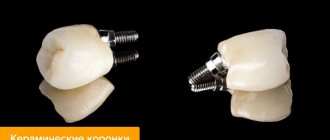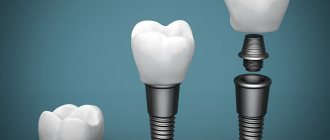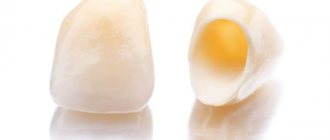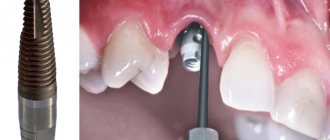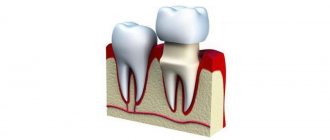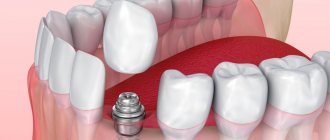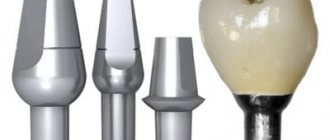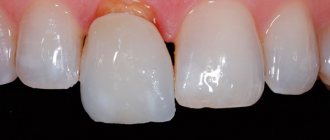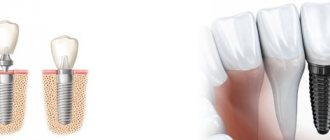What is a crown and when is it installed?
A crown is a single dental prosthesis that completely replicates the visible part of the tooth. This differs from an inlay or veneer, which imitate only a fragment of a tooth. Installation of a crown is required in case of significant damage to the tooth (30% or more), when classical filling is unable to ensure proper functionality of the dental unit. A crown is also placed when a tooth is lost. In this case, the support for the prosthesis is provided by neighboring teeth or an implant that replaces the root of the lost tooth. Depending on the design features, the method of attaching the crown is selected.
Screw fixation
The screw fixation option has been used by dentists all over the world for a long time, and it is still in demand today. The method is implemented in one of the following ways:
1) The abutment and crown are connected and then attached to the implant;
2) The implant and abutment are connected, after which the crown is attached to them.
The screw connection is popular because it has many advantages. More specifically:
the presence of a seat for a screw on the occlusal surface of the crown. The actual connection between the components occurs with its help; the crown can be removed and reinstalled. This is necessary if it is damaged or uncomfortable; the prosthesis can be processed even when the distance between the teeth is small.
A special feature of this fixation option is that the screw loosens during use. This can be eliminated due to precise fit. The cost of such a precise design is low, but the professionalism of the dentist is of great importance.
Fixing crowns on natural teeth
Installing crowns is a fairly lengthy process that takes several stages. First, the patient undergoes an examination and diagnosis, during which indications and contraindications for crown installation are determined. An X-ray examination allows you to assess the extent of tooth damage and create an optimal treatment plan. Immediately after diagnosis, the main stages of tooth restoration begin.
- Tooth preparation.
The abutment tooth is turned to install a crown or prosthesis. The depth of treatment largely depends on the material of the crown (for ceramics 1 millimeter is enough, for metal ceramics - 2 or more millimeters). In the vast majority of cases, before installing a crown, the patient undergoes a tooth depulpation procedure (due to the presence of diseases and the risk of their development under the crown). - Taking an impression
for subsequent making of a crown. - Installation of a temporary crown.
To hide the aesthetic defect and protect the tooth from the external environment, the patient is given a temporary crown, which is fixed with temporary cement. - Trying on a permanent crown.
To understand how accurately the crown is made and whether the patient will be comfortable with it, a fitting is performed before installation. Sometimes a permanent crown is fixed with temporary cement to make it easier to remove if discomfort or complications arise. However, modern digital diagnostic and manufacturing techniques, in particular CAD/CAM, have made it possible to manufacture products with perfect accuracy. - Permanent fixation of the crown.
The reliability of fixation largely depends on the quality of the cement. There are different types of dental cement: glass ionomer, composite, zinc oxide (temporary). The type of cement is selected depending on the type of structure (single or bridge prosthesis), as well as taking into account the characteristics of a particular clinical case.
Operational characteristics
The degree of fixation depends on the characteristics of the temporary cement. One of its important properties is the retention force, which allows you to hold the structure and remove it if necessary. The optimal characteristics of temporary cements include:
- good adhesion of indirect restoration;
- ease of mixing and application;
- ease of removal after fixation of cement residues from prepared structures and outer surfaces of the crown;
- adequate working hours;
- optimal viscosity for comfortable use;
- easy removal of the structure without damaging nearby tissues;
- biocompatibility with abutment tooth structures and soft tissues;
- long shelf life;
- no effect on the adhesion of permanent cement.
To identify and remove excess cement, it must be radiopaque. Today, none of the temporary cements on the market have absolutely all of the above properties. It is advisable to use each of them for a specific purpose due to the lack of a single universal solution.
Fixing crowns on implants
In case of complete loss of a tooth or the impossibility of classical prosthetics, the best solution would be implantation, thanks to which the functionality of the dental unit can be completely restored. The implant replaces the root of the tooth, and the prosthesis replaces the crown part. An abutment is a kind of adapter between these two components. As a result, the patient receives a solid structure, all elements of which are securely connected to each other. There are two methods of fixing implant-supported crowns.
- Cement fixation.
The essence of the method is similar to installing a crown on a natural tooth, only an abutment is used as a support. - Screw vixation.
The crown is connected to the abutment using a special screw that passes through the entire body of the crown. The resulting hole is subsequently closed with a composite material.
Each of the two methods has its fans and opponents among clinicians, however, both cement and screw fixation on implants are actively used in modern practice.
Pros and cons of cement fixation of crowns on implants:
- Lower cost.
- Ease of implementation.
- Better occlusion for prosthetics of chewing teeth.
- Better suited for bridges.
- Lack of possibility of prompt repair and prevention.
- There is a risk of cement resorption and decementation of the crown, which leads to a violation of the tightness.
- Risk of peri-implantitis when cement is removed beyond the working area.
Pros and cons of screw fixation of crowns on implants:
- A more modern type of fixation.
- A screw-retained crown is considered the best solution for single prosthetics.
- Integrity of structure and absence of cement.
- Good maintainability.
- Higher cost and manufacturing complexity compared to cement fixation.
- Risk of screw breakage or loosening.
- Many experts consider this method less universal.
The choice of the type of fixation is made by the doctor after analyzing the diagnostic results, assessing the clinical case and the anatomical features of the patient’s dental system.
Complications
Due to temporary fixation, the following complications are possible:
- de-cementing;
- damage to the supporting structure;
- breakage of the orthopedic structure during removal;
- development of gingivitis or peri-implantitis due to insufficient removal of temporary cement from the gingival sulcus.
The most severe complication is peri-implantitis, in the event of which it is necessary to remove the structure as quickly as possible, remove excess cement and carry out anti-inflammatory measures.
Breakage of the prosthesis or supporting structures is possible due to too much retention force of the temporary cement. Most often, temporary crowns made of plastic or composite materials break. Correcting the situation is quite simple - the damage is glued together with plastic or composite right in the office.
When permanent structures are removed, the ceramic veneer often chips, which requires the manufacture of a new denture. Therefore, it is undesirable to fix ceramic or metal-ceramic prostheses with temporary cement. The least common cases in orthopedic dentistry are cases of breakage or fracture of the crown of a tooth and other damage to supporting structures. Also considered quite rare is the case of excessive load on the implant with the development of peri-implantitis.
Indications for crown installation
- A severely damaged tooth, more than 50%
, when a filling cannot restore it. The cause is most often advanced caries; - large chip due to injury. In this case, the root is intact. It is enough to put a crown on top to restore integrity;
- fluorosis A disease that manifests itself as stains on teeth that cannot be whitened. Appear from an excess of fluoride in the body;
- aesthetic restoration, in case of defects: curvatures, altered shape, dissatisfaction with the color of the enamel.
Which crown to choose?
In terms of cost, a metal-ceramic crown, as well as a titanium abutment for it, will cost less. They are more suitable for the chewing group of teeth, as they can withstand a greater chewing load and are less likely to cause ceramic chipping.
For the front teeth, the guideline will be determined by the physiology of your own teeth: how thin or thin the gums are, how transparent the enamel on the teeth is. When choosing metal-ceramics for the front teeth, the aesthetic appearance may not be very beautiful. Ideally, zirconium crowns are optimal for the frontal group, respectively, on a ceramic abutment.
How does crown cementation occur?
Fixation is the final stage of prosthetics. Basic actions:
- The prepared abutment is sandblasted to create a rough surface.
- Fitting in progress. Before placing the crown on permanent cement, you need to make sure that it is positioned correctly.
- The inner surface of the prosthesis is coated with dental glue and then placed on the abutment.
- After installing the structure, it is irradiated with a special lamp to speed up the hardening process.
- Carefully remove excess cement if it protrudes from under the crown.
An hour after the procedure, the prosthesis can be loaded. Maximum pressure is allowed every other day.
– NO ONE NEEDS IMPLANTS WITHOUT CROWNS.
The purpose of implantation is to create a durable, most physiological and reliable support for a denture. In order to achieve this goal, two points must be completed:
1. Have an idea about future prosthetics and its plan.
2. Based on the prosthetic plan, place implants of the required size in the desired position (implantological rule #2).
The tasks for the first point are performed by an orthopedic surgeon: he selects the optimal prosthetic scheme for you, taking into account a number of physiological parameters and, of course, your wishes. In good clinics and in the presence of a well-coordinated and competent team of dentists, the orthopedist is not concerned about the very possibility of installing implants, the presence/absence of bone tissue volumes, etc., since all this can be recreated using various methods of bone and gum augmentation. Which is already the task of the implantologist.
In general terms and depending on the clinical situation, you may be offered the following prosthetic schemes:
Based on the prosthetic plan, an implantation scheme is formed, the sizes of the implants and the places for their installation are determined. This requires good and clear communication between the prosthodontist and the implantologist, plus adherence to positioning rules (see Recommendations for implantation, part V). In our clinic, orthopedists also help you choose an implant system that is suitable for your clinical case, since a correctly selected macro-design of an implant can significantly facilitate and reduce the cost of prosthetics. It is for this reason that we have set a fixed price for the installation of any implants.
The easiest (but not the cheapest) way to avoid mistakes when positioning is to use surgical templates:
They are also made by an orthopedic doctor and, in fact, repeat the future prosthetic design.
Surgical templates are either bone or supragingival. The first, more accurate ones, are often used to “bypass” some anatomical obstacles - maxillary sinuses, nerve trunks, etc. The second simply orient the implant along the axis with a known error, which allows osteoplasty, tooth extraction, etc. simultaneously with implantation.
Thus, dear friends, when planning and carrying out implantation
An orthopedic doctor is the most important and most necessary doctor.
Implantological treatment, dental rehabilitation using dental implants, begins with a consultation with an orthopedist . And not an implantologist, as many people think.
The easiest way to imagine this stage of preparation for implantation is to compare it with building a house.
Imagine that you have a plot of land and lots and lots of extra money. You want to build a house. Where do you start?
Probably, for starters, you will invite a surveyor and some geological topographical engineer. They will mark your site, determine the nature of the soil, the groundwater level and give you a conclusion whether it is possible to build something on it at all. And, if possible, what size? In fact, this is the diagnosis and examination that we conduct at the very beginning of any treatment.
Then, you will invite an architect who, using the data received from surveyors and geologists, will design your future home. When planning the number of storeys, the number of bedrooms and bathrooms, he will be based, among other things, on your wishes, lifestyle, etc. And, if you are dealing with a good architect, he will never provide you with an uncontested project - you will always have a choice and the ability to make adjustments. This is exactly how prosthetics are planned.
At the next stage, the project of the future house is transferred to an engineer, whose task is to calculate and construct the foundation. It can be completely different, but it must be reliable and technologically related to the design of your home. If you are planning to build a wooden country house, a simple pile or strip foundation will be enough, but if you plan to build a skyscraper, then the support of your modest Trump Tower should be appropriate. In our case, this is the implantation planning stage.
We do not know a single person who, having first poured the foundation, would call an architect and demand that he build the house of his dreams on this foundation. We do not know of a single construction organization that would start building a house without a design and the necessary geodetic and geological surveys. But, alas, in implantology and prosthetics this approach is very common, and a violation of the sequence of decision-making is one of the main causes of errors, complications and subsequent disappointment for patients.
When all the plans have been drawn up, the decisions have been agreed upon, and you have no questions left - you can begin installing the implants.
Metal-ceramic crown.
They are a metal frame covered with ceramic mass on top. Can be installed on any teeth. There are some aesthetic disadvantages in the area of the anterior teeth. If the gums are naturally thin, the metal edge of the crown will be visible through the gums. If the enamel of your own teeth, located together with the tooth on the implant, is highly translucent, then the metal-ceramic crown will stand out against this background. On chewing teeth, such crowns perform their function perfectly.
A titanium abutment is installed under the metal-ceramic crown. There is no need for zirconium. Some dentists may offer a cobalt-chromium alloy abutment. It is up to the patient to decide whether or not to agree to this abutment option, but they are extremely unreliable and there is a risk of such an abutment breaking. It cannot be replaced, so it is removed along with the implant.
Three ways to attach crowns or dentures during implantation
- Cement - attachment to the abutment is performed using composite glue. It has good shock-absorbing properties. The most common type of fixation, which simplifies the installation of a bridge consisting of several elements.
- Screw - the crown is secured to the abutment outside the oral cavity. The resulting structure must be screwed into the implant. A technological hole is used through which a screw is screwed. To disguise it, a composite material is used.
- Telescopic - involves the use of double crowns: one is fixed to the abutment, the other is mounted into the body of the prosthesis.
Grigoriev Alexander.
SCAD member, academic director. International lecturer on adhesion and interdisciplinary restoration.
Highly aesthetic works from metal ceramics, press ceramics and frame ceramics on zirconium and aluminum oxide are a reality today. The skills and craftsmanship of the medical technician team create masterpieces that stun patients with their results. Today, aesthetic rehabilitation services can improve the patient’s personal status and sometimes change their fate.
But there is also a downside to this happiness: a chip of a fragment of ceramics, a chip of a veneer, a disintegration of an orthopedic crown, and sometimes even a defect in the tooth stump. Moments of happiness stop at this moment for our patient. The beloved restoration is no longer pleasing to the eye.
Using the example of one clinical case, I will show how to effectively and accurately carry out the inversion (reverse) prosthetics method.
Patient M., 35 years old, came to the clinic with complaints of decementing of an aluminum oxide crown by 2.1.
Objectively: the crown had a movable position on the stump of tooth 2.1 and was removed without effort. A chipping of 1/3 of the tooth stump was noted (the inner part of the crown was filled with the separated fragment).
Defect of stump of 2.1 tooth
In the past, the tooth was subjected to endotherapy followed by restoration using a polymer post. There was complete preservation of the polymer pin throughout. Only the inner surface of the crown with a fragment of core material broke off.
Taking impressions to make a crown
Today, there are two known methods of taking impressions, which are used when it is necessary to make a prosthesis on implants:
- Closed spoon method;
- Open spoon method.
The first method is used exclusively for single structures or when using two dental implants fixed parallel to each other.
A more complex option is the “closed spoon method”, but it has higher accuracy. Can be used when installing several titanium structures or when they are located at an angle relative to each other. The only limitation for this method is the need to fix the crown at the end of the dentition.
As for the production period of the prosthesis, in general it takes about 14-28 days. As a rule, the first two weeks are required to receive the abutments, and the remaining time is occupied by the actual procedure for creating the crown in the laboratory.
Implantation stage
Dental implantation is one of the main specializations of our dental center CLINIC IN. Every year we install about a thousand implants in a wide variety of clinical situations, from simple to incredibly complex, including, for example, bone tissue augmentation. Our doctors are mentors at Dentsply Sirona Implants; they teach other doctors how to work with implants and help them solve problems that arise in practice.
It's no surprise that we write a lot about implantation, implants and implant systems. There are even more of them on the website www.implant-in.com, which is mainly intended for doctors. In other words, you always have something to read, so we will skip this step.
Perhaps the only participation of the orthopedist at this stage is the so-called. “immediate prosthetics” – situations when the patient simply cannot be left without a tooth, even for a day. This regularly occurs with the so-called. “immediate implantation” in an aesthetically significant area - we remove the tooth, install an implant and immediately fix a temporary crown to it.
If you don’t delve too deeply into the nuances, then to implement such a treatment plan you need to fulfill a number of conditions:
– implant of the correct size and in the correct position
– sufficient, at least 15 Ncm, primary stability. If several implants are combined into a temporary prosthetic structure, the moment of force can be reduced to 10 Ncm.
– availability of necessary components for temporary prosthetics:
– sufficient and easily predictable volumes of soft tissue surrounding the implant.
– free time with an orthopedic doctor.
The decision to provide temporary prosthetics for a newly installed implant is made only after the implant has been installed.
In general, immediate implantation and, especially, prosthetics are an equation with a large number of variables that are not so easy to solve. Therefore, we will return to this topic later. For now, you just need to know that such a technique exists, and we actively use it:
